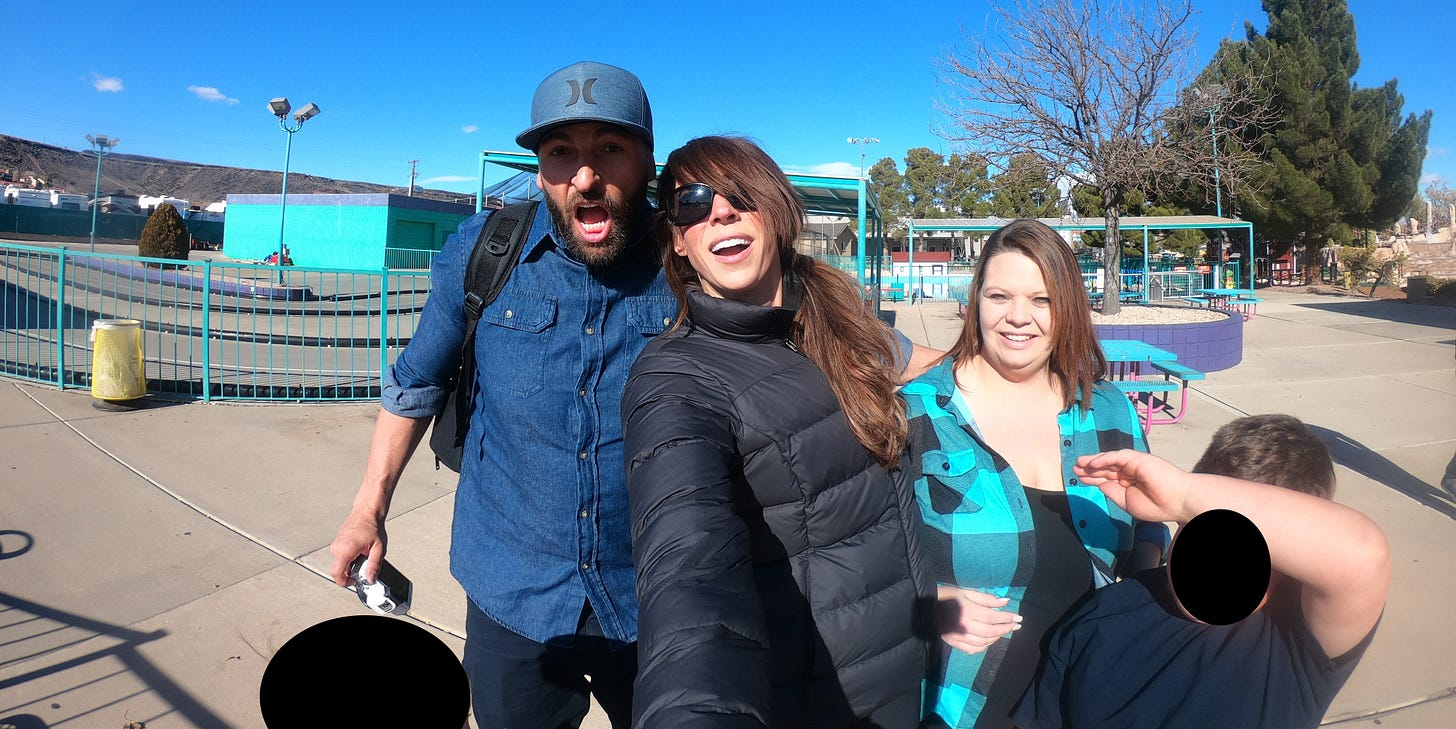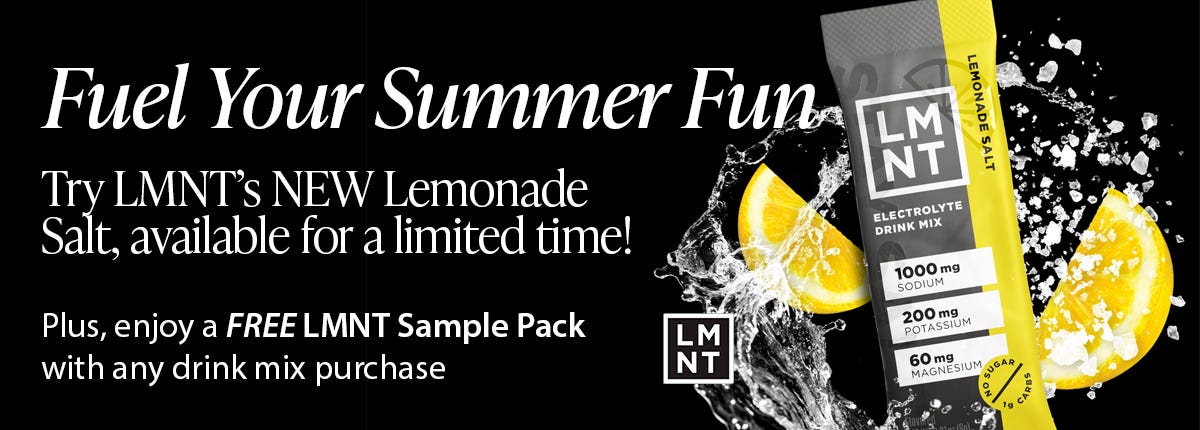My concussion story, part 1
In December 2018, I sustained a concussion, and developed persistent post-concussion symptoms. They took me years to resolve. Here is my origin story.
This issue is sponsored by LMNT Electrolytes. Read on to see how LMNT helped me post-concussion and with my POTS symptoms—and see how it can help YOU fuel your summer fun. Get a free 8-pack sampler of LMNT’s top flavors with any order. (And don’t sleep on their NEW limited-edition Lemonade Salt, the perfect fuel for summer!)
I never really knew what it meant to “see stars.” I’d imagine a character like Wile E. Coyote hit by a falling brick, sitting on the ground with cartoon twinkling stars spinning overhead. Turns out, it’s basically just like that. Although my “brick” was a laser tag gun, and the stars were my brain exploding in sudden pain.
On December 28, 2018, my now-husband took our son and nephew to a “fun center” in southern Utah. We started in the laser tag arena. It was dark, the lights were flashing, the music was blaring, and everything glowed neon under the blacklight. We had so much fun, we decided to go back in for one last game before we left. During that game, I remember ducking and twisting to avoid being tagged. Then came the stars, as I was hit hard behind my left ear.
To this day, I don’t for sure know what hit me, or what I hit. I assume it was someone else’s gun. They were large and heavy, the space was crowded, and it was hard to see. In the heat of the moment, I could see whipping around and catching someone accidentally. I also could have ducked and twisted into a nearby concrete pole—they were also hard to see, and I came-to lying near one.
The onset of symptoms
The hit knocked me to the floor. I saw stars, literally. I was never unconscious, but I was out of it for a few moments. I don’t remember people asking me if I was okay or helping me up. I rubbed my head and slowly shook it off, telling my family I was fine. I thought I was.
I felt off for the rest of the day, and had a splitting headache. Of course getting hit in the head would leave you with a headache. I was more irritable than normal, but I chalked that up to spending a few days with family in a small house. When we left the next day, I asked my husband to drive us home because I wasn’t feeling up to it. When we got home, I started working on an email at the kitchen counter. The words swam and I struggled to write, a task that usually comes effortlessly. I casually mentioned to my husband that I was having a hard time reading the screen. He immediately said, “I think you have a concussion.”
I blew him off. I thought concussions only happen to boxers and race car drivers, not to moms playing laser tag. I never threw up, and I was never unconscious. I figured I would “tough it out” and maintain my usual routine, like you sometimes do with a cold.
The diagnosis
I got sicker. I couldn’t work out. I developed crippling anxiety. Reading, focusing, and writing were impossible. I kept losing my words. I was irritable and short, which annoyed everyone around me (including me). A week later, at the behest of a friend, I went to a doctor. He diagnosed a concussion and told me to cancel my upcoming trip. I thought he was being overly dramatic. Then, as he started to describe everything I’d need to do to travel (packing, navigating a loud and busy airport, making my way through TSA) I started to cry. He said I could exercise if it felt okay, but I really needed more quiet rest time, ideally in a dark room.
I rested, but continued to get worse. I was dizzy all the time. I tried to “shake it off” and work out once, but had a panic attack on the turf—my first one in a decade. I started getting my period every two weeks, as someone who had been 28-days regular for years.
I couldn’t socialize, couldn’t spend time with my son, and struggled to work. I couldn’t do much of anything but lie down. Nothing eased my symptoms, and struggling to perform even basic household and care tasks left me incapacitated. It hit my mental health tremendously hard. I knew something was wrong, but my brain was so dysfunctional that I couldn’t make sense of any of it.

Physical therapy and vertigo
About a month after the accident, a physical therapist specializing in TBI reached out. She followed me on Instagram and urged me to come to Park City for an evaluation. That was the start of a five-year journey in methodically working through my symptoms, body system by body system.
We started with my vestibular system, helping me resettle the crystals in my ears and halt my vertigo. (This may sound like holistic mumbo-jumbo, but it’s real.) Otoconia are tiny crystals in your inner ear. They make you sensitive to gravity and help you keep your balance. Normally, a membrane in your ear keeps the crystals where they belong. If the ear is damaged, as can happen with a blow to the head, the crystals can shift to another part of the ear. When they are out of place, the crystals make you sensitive to movement and position changes, sparking vertigo, nausea, and balance issues.
Guided exercises like the Epley maneuver and BBQ rolls (yes, also a real thing) helped me resettle the crystals, resolving most of my vertigo. We had to repeat these moves many times over, but they worked. I remember walking out of my first PT appointment with 75% of my vertigo resolved. I cried in my car from the relief.
Primitive reflex work
We also addressed the primitive reflexes that had returned as a result of my concussion. Primitive reflexes are automatic movements controlled by the brainstem, present in infancy. They are essential for a newborn’s survival, but incredibly disruptive when present in adults. As the brain and nervous system mature, these reflexes make way for higher functioning. However, head trauma can cause these primitive reflexes to reappear. This can manifest as balance issues, vision problems, motion sensitivity, and cognitive difficulties. (One primitive reflex, the Moro response, is also tied to the fight or flight response, and is likely why my anxiety was off the charts.)
Primitive reflex work was the foundation of my concussion treatment. Until these were addressed and resolved, healing in other areas (like vision and nervous system regulation) weren’t possible. This physical therapy took a few weeks, and helped tremendously—but still only left me feeling halfway better. (I also had to revisit this work several times throughout my treatment. It wasn’t a “one and done.”)
This is one such exercise for primitive reflexes, called “the archer.” It’s related to the Asymmetrical Tonic Neck Reflex, or ATNR.
Addressing my vision system
Once I was ready, we moved onto my vision system, which was largely affected. I worked for months to re-train my eyes to work well together and coordinate signals with my body.
The exercises I did here were wild. There were vision exercises, including work with a Brock string. I also did physical therapy combined with vision. In one, I’d bounce a 10-sided ball with numbers (from 1 - 10) printed on each side. I had to catch it one-handed, call out the number, repeat with the other hand, then add those numbers together. (See video.) In another, my PT threw a soccer ball at me while I was standing at 90 degrees (not facing her; looking with my peripheral vision only). I had to catch the ball and name a food that started with A, then B, then C with each catch. I had to bounce on a trampoline and connect dots with my eyes
Graduated… but not done yet
After a few months here, I “graduated” from PT and was sent back into the world to keep working on my exercises. I was feeling much better, but not good. I’d take a giant step forward, then two steps back. I’d mostly resolve one set of symptoms, then a new one would pop up.
What was happening in my body felt seemed unrelated to a concussion, and highly weird. I could no longer wear compression socks on a hike; they made me “bonk.” Easy hikes were impossibly hard; I had no energy no matter how much I fueled. I couldn’t sit in hot tubs; even a few minutes left me spinning and nauseous. Lying back in a dentist chair brought my symptoms back in full force.
Interlude: In looking back at old photos and videos, I’m astounded at everything I still managed to do, as sick as I was. Expo West, book tour events, photo shoots… I managed because I had to, but it definitely hurt my recovery. Looking back, I would have canceled more, like my team and husband were encouraging me to do. I tried to “stick it out” for years, to my own detriment.
POTS, or nervous system dysregulation
In August 2020, my PT heard me mention my compression sock issue on a podcast I had recorded. She immediately called me back into the office and put me on a treadmill for the Buffalo Treadmill Test.
This test is used to assess tolerance to physical activity after a concussion. I walked on a treadmill at increasing speeds and inclines, with my PT monitoring my heart rate, perceived exertion, and symptom levels. Not even halfway through the test, my heart rate plummeted from 140 to the 60’s. She immediately stopped the test and diagnosed a concussion-related condition similar to POTS (Postural Orthostatic Tachycardia Syndrome). As I didn’t have all of the manifestations of POTS, she referred to it as “autonomic nervous system dysregulation,” or “dysautonomia.”
Essentially, my nervous system was no longer regulating my blood pressure or heart rate effectively, especially under demand. We determined my specific triggers were exercise, heat, and altitude. (Great news for someone who hikes all summer long at 10,000 feet, and flies regularly for work.) This dysautonomia also resulted in erratic blood pressure fluctuations—either too high or too low. This was that “bonk” feeling I’d notice even on easy hikes, especially with compression socks.
This was the final piece of my concussion puzzle, and was the point where I started to achieve lasting symptom resolution.
Coming up in Part 2: Post-concussion and POTS
I never imagined that a simple game of laser tag could change my life in so many ways. What started as a sudden blow to the head turned into years of pain, loneliness, frustration, and a reality I couldn’t have predicted. I was only beginning to understand the full toll this injury would take.
In Part 2, I share how this most recent diagnosis finally helped me put the pieces together. Over the next three years, my life would start to resemble what it had before the accident. And I won’t spoil the ending, but in the spirit of encouragement, I’ll tell you it’s a happy one.
For now, if you’re reading this and recognizing some of these symptoms in yourself, please know it gets better. Please don’t dismiss your symptoms or try to “tough it out.” Know that you are not alone. As a starting place, look for a local physical therapist, occupational therapist, or neurologist who specializes in TBI for an evaluation. (I’ll do my best to share more resources throughout this series.)
Feel free to share this article series with anyone suffering from a concussion or post-concussion symptoms—and the people who care for them. There aren’t enough resources for people dealing with post-concussion syndrome, especially in women.
XO, MU
P.S. One tip I’ll give you now is to get enough electrolytes. In fact, LMNT Electrolytes played a HUGE role in my post-concussion therapy. LMNT’s sodium-forward balanced formula was recommended by my physical therapist to mitigate my POTS-like symptoms. I noticed an immediate improvement in energy, focus, and general health with the right supplementation—a feeling echoed by those of you taking it during your hikes, workouts, paddles, and landscaping. You don’t have to be post-concussion to reap the benefits! If you’re out in the heat of summer playing or working, LMNT can keep you hydrated, muscle-cramp free, and energized. Get a free 8-pack sampler of LMNT’s top flavors with any order, including the new Lemonade Salt.







I have never experienced this but, wow, what a helpful post! I'm always amazed at your generosity.
I’m going through this exact experience right now. I passed out (don’t know why) fell backward and hit the back of my head splitting it open on my cast iron tub surround on May 3rd and it had been a roller coaster of improvements and backslides ever since. I don’t have vestibular headaches, now I do…I don’t need a walker, now I do…now I don’t again… I sound normal, now I don’t…. It has been symptom whack-a-mole. Finding this post felt kismet. My speech has also been affected, along with really similar things to what you have shared. It is challenging to articulate what’s not right to people! You’ve done a lovely job describing it. Waiting for part two impatiently! ☺️